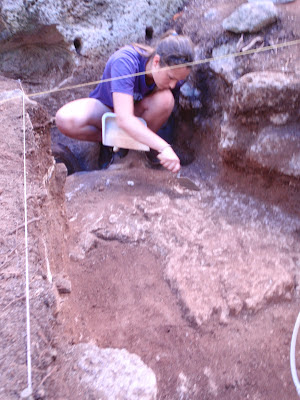Hitting Rock Bottom
What a frenetic couple of days. After a very lazy Sunday/day off, spent mostly sleeping (and Mike R. spent watching almost a whole season of The Wire in one sitting) Monday rolled around and the students were champing at the bit to dig. Removing the rubble layer exposed a beautiful smooth layer of medium brown loam, which felt like trowling butter after the rocky stuff above it.
This layer was essentially the dirt floor of the house during its occupation and revealed a wide array of artifacts: lots of fish bones (some quite large), pieces of plain and polychrome "delft", coarse earthenware with a apple-green glaze (17th century), a musketball, and several pieces of blackish-green handblown bottles. Most intriguing of all were two flakes of worked chert - first because I've never seen chert in Bermuda and it was definitely imported and second because of the documented presence of eight enslaved Native Americans living on Smiths Island in the late 17th century.
As the digging proceeded and the depth increased, some interesting digging styles emerged:
A healthy rivalry is developing between Jordan and "the A Team" next door, while Leigh watches on bemused.
By the end of the day, we were coming down on the stone floor of the house, quarried out of the hillside when it was originally built. As we began troweling the surface, several features cut into the stone began to emerge.
We also welcomed back to the island a Smiths Island Archaeology veteran - Alexandra, who dug with me in 2010, helped find the Oven Site, and excavated the first unit. She's here as a museum cataloger imposing order on Carter House Museum's collection of objects and artifacts. As experienced as she is, her days off will not be safe - I know where she lives and will surely send a press gang over to shanghai her and spirit her off to Smiths Island...
This layer was essentially the dirt floor of the house during its occupation and revealed a wide array of artifacts: lots of fish bones (some quite large), pieces of plain and polychrome "delft", coarse earthenware with a apple-green glaze (17th century), a musketball, and several pieces of blackish-green handblown bottles. Most intriguing of all were two flakes of worked chert - first because I've never seen chert in Bermuda and it was definitely imported and second because of the documented presence of eight enslaved Native Americans living on Smiths Island in the late 17th century.
As the digging proceeded and the depth increased, some interesting digging styles emerged:
and then laying down on the job:
 |
| Quarin and Mimi dig so fast their arms are just blurs... |
That evening at the archaeology lab, we had a lecture session on ceramics identification (porcelain, stoneware, earthenwares), which was timely given our finds of the day. What was especially noteworthy was what we DIDN'T find in these occupation layers: white salt-glazed stoneware, creamware, pearlware, and the other ubiquitous, mass-produced ware types of the mid to late-18th century. While one must use absences of evidence carefully, this suggests that the site was abandoned by the mid-18th c. or if its occupation persisted, that the residents were too poor to afford ceramics readily available just across the harbour in St. George's. We also benefited from having a visiting osteology expert identify bones and lecture on studying human remains (thanks, Jill!) and walk the students through her analysis of the skeleton of Sir Jacob Wheate,a Royal Navy captain who died in Bermuda in 1783, who was laid out on the lab table for close study.
Some of the fishbones we recovered from the occupation layer
We also welcomed back to the island a Smiths Island Archaeology veteran - Alexandra, who dug with me in 2010, helped find the Oven Site, and excavated the first unit. She's here as a museum cataloger imposing order on Carter House Museum's collection of objects and artifacts. As experienced as she is, her days off will not be safe - I know where she lives and will surely send a press gang over to shanghai her and spirit her off to Smiths Island...






.jpg)
Comments